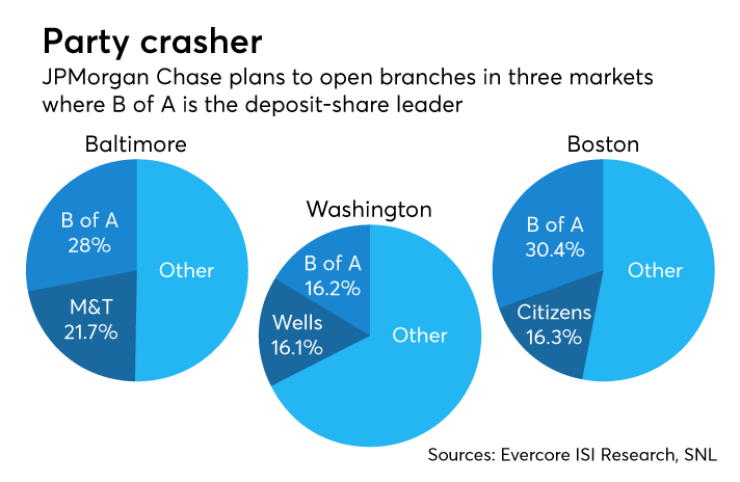Innovation has been the name of the game in banking. So when JPMorgan Chase outlined plans to add 400 brick-and-mortar branches in new markets, it sounded like a blast from the past.
In a surprise announcement Tuesday, the New York megabank said it plans to use a portion of its tax savings to build its brand the old-fashioned way in cities such as Boston, Philadelphia and Washington, adding branches in 15-20 markets in several states and hiring as many as 3,000 new employees.
The expansion — part of a larger, $20 billion investment program — follows recent promises by executives to invest a portion of JPMorgan’s tax savings in long-term growth. Still, the total cost caught some analysts off guard and guaranteed that the company will be dogged by questions for years to come about whether the ambitious investment will pay off.
Perhaps the biggest takeaway for the industry, though, is what it means for JPMorgan’s smaller competitors. The company’s retail unit has been a

“If banks are smart, they won’t lower their underwriting standards, but they will compete on price,” said Charles Peabody, an analyst with Compass Point Research & Trading. If JPMorgan starts competing on price, that could put smaller local peers at a disadvantage, he said.
JPMorgan’s heavy investment in branches stands in
“It’s going to be an interesting test on whether you do need a physical presence, given all of the money that’s being put into the digital and mobile presence,” Peabody said.
JPMorgan has
Over the past few years, the company has
JPMorgan did not provide projections about its total branch count over the long term as part of its announcement Tuesday.
Its consumer bank has added customers by investing in new technology. Active mobile customers rose 13% during the fourth quarter from a year earlier, to just over 30 million.
However, by opening full-service branches in several major markets where it had not had any before, JPMorgan is taking a number of major competitors head-on.
“The head of our company is our retail branches,” Gordon Smith, CEO of consumer and community banking, said in a press release announcing the expansion. “We are a leader in 23 states but aren’t yet in major markets like Washington, D.C., Boston, Philadelphia and many others.”
According to Evercore ISI, Bank of America holds the largest deposit share in Boston (30.4%) and in Washington (16.2%). Wells Fargo and Capital One are close behind in Washington, and Citizens Financial Group has a 16.3% share in Boston.
But a number of community banks top the charts, as well. For instance, the $7.4 billion-asset EagleBank in Bethesda, Md., controls 3% of the deposits in the Washington metro area, while the $10.7 billion-asset Eastern Bank controls 4% of the market in Boston.
“JPMorgan has maintained — and successfully so — that there is a need for bricks, particularly if they’re entering new markets,” Peabody said.
Under the broader investment plant announced Tuesday, JPMorgan said it will increase its minimum wage for employees to as high as $18 per hour. It will also reduce out-of-pocket medical expenses and offer annual bonuses among other compensation benefits.
The company pledged to increase its charitable giving and boost lending to small businesses and for low-income homeowners.
Taken in context, JPMorgan’s plan for its tax savings appears largely in line with those of its peers, with the breakdown in fixed costs and “growth initiatives,” according to Peabody.
In the year ahead, costs are expected to increase by an additional 1.5% to 2% as the company “shares the wealth” from the corporate tax cut. Those expenses, however, will be largely outweighed by expectations for stronger lending.
Still, the $20 billion price tag was hard for some to swallow.
“Initially, we were shocked by the $20 billion investment headline,” though the investments in new branches aren't expected to significantly increase costs over time, KBW analyst Brian Kleinhanzl wrote in a Jan. 23 note to clients.
In the year ahead, the biggest question facing the company is whether its bet on the future of physical branches will be too aggressive.
“A lot of people don’t think bricks are the way to go,” Peabody said.





